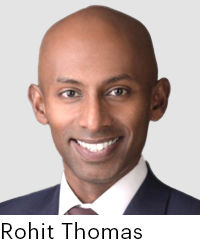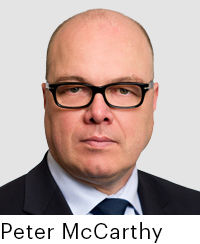
BMO Insurance has over the years, somewhat by design, kept a lower profile than some of its peers in the industry. With a new change in leadership afoot, however, the company’s new president says this might be changing going forward.
The comments were part of a recent Insurance Portal discussion with both Rohit Thomas, BMO Insurance’s president and CEO, and Peter McCarthy who led the banks’ insurance arm from 2009 until 2023 when he transitioned to his current position of Vice Chair. Thomas, returned to the company after three years with TD Insurance where he held the position of Vice President Life & Health. He took over as President & CEO of BMO Insurance in March 2023. From 2014 to 2020, he held the position of VP & Chief Pricing Actuary at BMO Life Insurance.

The company’s approach thus far, they say, has been to speak with each advisor individually. They also say in the defined benefit (DB) pension derisking space – a key area of focus for BMO Insurance – that the company knows all of the actuarial consultants in the business. “In those markets, we talk to brokers one at a time. And actuarial consultants, there are only so many of them. We know them all,” says McCarthy. “You don’t need to do a press release to tell them that we sold a big pension, even though we’ve done many big pensions, because they all know.”
In an interview with the Insurance Portal in 2019, Rohit Thomas mentioned a $322 million pension derisking deal as being the largest transaction for a single annuity of BMO Insurance’s history. The insurer remains an important competitor in that field until now. According to the most recent Pension Risk Transfer Report from the actuarial firm Eckler, BMO Insurance increased its market share from 9 % in 2021 to 14% in 2022, making them 4th, on the heels of Desjardins, 3rd with a 15 % market share. In 2022, the market was dominated by Sun Life, with a market share of 27 %, and Brookfield Annuity with 26 %. The next report is expected in July 2024.
Marketing, says Thomas, specifically press releases, do not add a lot of value to the business.
Thought leadership
That said, the president would appear to realize the need for a higher profile, saying they have asked the company’s board of directors to give it latitude to disseminate more information and thought leadership using both traditional methods and relatively newer ones (social media).
“How do you get that message across (to) educate customers and advisors? We still very much value the one-on-one relationship, the MGA relationship, but I think we’ll continue to build that profile,” Thomas says.
Market share
As for where it stands relative to its peers in the industry, both executives say the company prefers to focus on net new sales, rather than total market share, particularly as the company has only been in the insurance business since 1988, operating without the 100-year history that some of its competitors can boast. The company is also not active in employee benefits – a segment which can make up more than half of a company’s premiums in some cases.
Total market share, they add, is not an apples-to-apples comparison.
“We do compare market share in the markets we intend to be in – traditional universal life, whole life, term and critical illness products, annuities, segregated funds and re-risking pension plans. Those markets we aim to be in the top five, top three for new sales,” Thomas says. “We really started in 1988. Very small acquisitions are older than that, but (that business) would be very small. We don’t have the in-force blocks behind us.”
High-net-worth space
What the company has done in recent years, however, has been to focus on the high-net-worth (HNW) space, particularly in advisory sales of universal life, whole life, term and critical illness products, annuities and segregated funds.
In 2016 and in 2017 the company began an effort to serve the HNW market, a space that the executives say has been fantastic for the company. As evidence, they say the average premium paid in 2016 was $2,105. Today, the company’s average premiums paid come in above $9,976.
Managing general agencies
They add that BMO Insurance is interested in “doubling down” in the Managing General Agency space, calling it a key area of focus for the company. That doubling down includes improving digital capabilities, streamlined and accelerated underwriting, and product innovation.
To that end, they say the insurance division’s work with the bank’s capital markets group has been pivotal in developing a product shelf that is unrivalled by competitors.
“We really tried to leverage a lot of capabilities we can with BMO. One of the units, capital markets, is one of the best, the strongest in the country,” Thomas says. “We have a unit within BMO Capital Markets and we work very closely with them to launch these products.” The insurer also works with BMO Asset Management on products.
Investment products
He adds that the company has always been a market leader in offering investment products, saying the firm offers more than 300 options within Universal Life – ETFs and mutual funds from various providers. “Other carriers to this day offer around 30 investment options.”
Thomas and McCarthy see index options strategy as a distinctive feature for BMO Insurance life products. According to them, these complex investment options which use derivatives and indices allow BMO Insurance to “leverage all the capabilities within Bank of Montreal”. They say BMO Asset Management and BMO Capital Markets helped structuring the investment options strategies in the universal life (UL) and whole life non participative policies.
As an example, the two executives mention the performance bonus offered on its whole life policy. The documentation provided states that the insurer calculates the rate of the performance bonus each year. The bonus is then automatically used to purchase additional paid-up insurance coverage which increases the amount of the death benefit and cash value at no additional cost.
The rate of the performance bonus can change from year-to-year. It is guaranteed to never be negative. The rate is actually 5.5 %, until April 30, 2024. Next rate will be known on May 1, 2024.
Thomas and McCarthy also see as distinctive the Guaranteed Market Index Account (GMIA), an option strategy launched by BMO Insurance in 2014 on its UL policies. Structured by BMO Capital Markets, GMIA uses a combination of 10 years bonds and call options to support a minimum guaranteed rate of return. GMIA is also participating in equity linked returns.
Digital strategy
Finally, the executives say the company is focused on a “digital first” agenda, including digitizing key processes for advisors to make it easier to do business with them. Initially the company focused on digitizing new business (i.e., e-delivery of policies) and now it is focusing on enhancing the digital experience on the service side. Digital first means at every point of contact, the insurer aims to digitally enable the experience for the advisor.
New advisors
“How do we get new advisors? How do we support new advisors, especially in the communities, the segments that are being untapped?” Thomas asks. “We have to figure that out as an industry.”
Equally important, perhaps, is the need to make insurance seem as indispensable as travel insurance. “It’s something you shouldn’t live without,” he adds. “Insurance does a lot of societal good. I think, as an industry, we can do a better job of making it as important as travel insurance.” This, he adds, will require a concerted effort on the part of media, regulators and brokers alike.
Similarly, he says it’s important to push the value of financial planning. “People don’t become good savers online by themselves. People need good advice.”
Asset exposure of the whole life portfolio
12 months before now
- BMO Insurance agrees with BMO Capital Markets to buy 100 shares of a fund with performance linked to a specified market index at a price of $1,000. That is the call option.
- Cost of the call option for BMO Insurance: $50
Now (after a year)
- The market value of 100 shares in the fund increases from $1,000 to $1,200.
- BMO Insurance exercise the call option to buy the shares of the fund from BMO Capital Markets for $1,000 and then sell the same shares on the market for $1,200, giving it a gain of $200.
- This gain contributes to the calculation of interest credited the fund value of the policy.
- The market value of the shares decreased from $1,000 to $800
- BMO will not exercise the call option.




